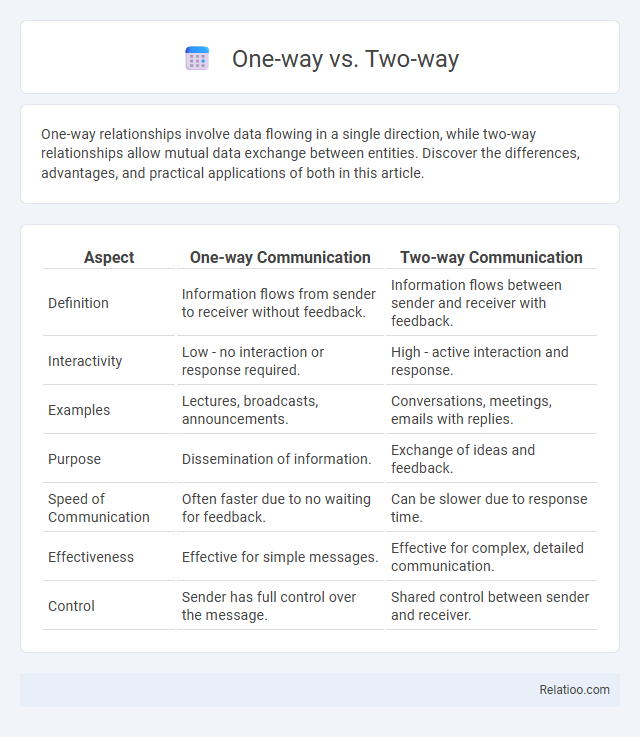One-way relationships involve data flowing in a single direction, while two-way relationships allow mutual data exchange between entities. Discover the differences, advantages, and practical applications of both in this article.
Table of Comparison
| Aspect | One-way Communication | Two-way Communication |
|---|---|---|
| Definition | Information flows from sender to receiver without feedback. | Information flows between sender and receiver with feedback. |
| Interactivity | Low - no interaction or response required. | High - active interaction and response. |
| Examples | Lectures, broadcasts, announcements. | Conversations, meetings, emails with replies. |
| Purpose | Dissemination of information. | Exchange of ideas and feedback. |
| Speed of Communication | Often faster due to no waiting for feedback. | Can be slower due to response time. |
| Effectiveness | Effective for simple messages. | Effective for complex, detailed communication. |
| Control | Sender has full control over the message. | Shared control between sender and receiver. |
Introduction to One-way and Two-way Communication
One-way communication involves a single direction of information flow, where messages are transmitted without expecting feedback, commonly used in broadcasts or announcements. Two-way communication enables an interactive exchange, allowing both sender and receiver to share messages, ask questions, and provide feedback, essential for collaboration and effective problem-solving. Understanding these dynamics helps you choose the most efficient communication style for your organization's needs.
Defining One-way Communication
One-way communication is a unidirectional flow of information where the sender transmits a message without expecting feedback or interaction from the receiver. This communication style is common in broadcasts, announcements, or instructional settings where clarity and brevity are crucial. Understanding your use of one-way communication helps improve message delivery but limits engagement and response opportunities.
Understanding Two-way Communication
Two-way communication facilitates interactive exchange between sender and receiver, enabling feedback and clarification that enhance mutual understanding. Unlike one-way communication, which transmits messages without direct response, two-way communication supports dynamic dialogue essential for collaboration and relationship building. Power dynamics influence communication flow, as balanced power fosters open exchanges, while imbalanced power may restrict feedback and hinder effective communication.
Key Differences Between One-way and Two-way Communication
One-way communication involves a sender transmitting information to a receiver without expecting feedback, commonly used in announcements and broadcasts. Two-way communication facilitates an interactive exchange where both parties actively send and receive messages, enabling clarification and immediate response. Power dynamics influence these communication types by determining control over message flow, with one-way often reflecting hierarchical or authoritative settings and two-way promoting collaborative environments.
Advantages of One-way Communication
One-way communication offers a clear, efficient transfer of information, minimizing misunderstandings by delivering a consistent message to a broad audience. It allows for rapid dissemination and easy control over the content, making it ideal for announcements, instructions, or emergency alerts. This communication model reduces feedback noise, ensuring the focus remains on the core message without distractions.
Benefits of Two-way Communication
Two-way communication enhances feedback opportunities, fostering clearer understanding and immediate problem resolution between parties. This dynamic improves collaboration and trust, resulting in increased engagement and productivity. Businesses leveraging two-way communication experience higher customer satisfaction and more effective decision-making processes.
Drawbacks of One-way Communication
One-way communication often results in limited feedback and reduced engagement, which can lead to misunderstandings and decreased employee motivation. This communication style impairs collaborative problem solving and stifles innovation by preventing the exchange of diverse perspectives. Organizations relying heavily on one-way communication risk creating information silos and poor decision-making due to a lack of input from frontline teams.
Challenges of Two-way Communication
Two-way communication often faces challenges such as misinterpretations, delayed feedback, and difficulty in maintaining message clarity, which can disrupt effective information exchange. Your efforts may be further complicated by emotional biases or cultural differences that impact the receiver's understanding and response. Overcoming these obstacles requires active listening, precise messaging, and patience to ensure mutual comprehension and collaboration.
Choosing the Right Communication Method
Choosing the right communication method depends on your goals and context, whether it's one-way, two-way, or power dynamic communication. One-way communication efficiently delivers clear messages without feedback, ideal for announcements or instructions. Two-way communication fosters engagement and collaboration by allowing interaction, while power dynamic communication emphasizes authority, useful for establishing control or making decisions.
Conclusion: One-way vs Two-way Communication
One-way communication involves a sender transmitting information without expecting immediate feedback, which can be efficient for straightforward messages but may limit engagement and clarity. Two-way communication encourages interaction and feedback, fostering better understanding and collaboration, essential for complex or sensitive topics. Your choice between these dynamics should depend on the communication goals, context, and desired level of participation from the audience.

Infographic: One-way vs Two-way
 relatioo.com
relatioo.com